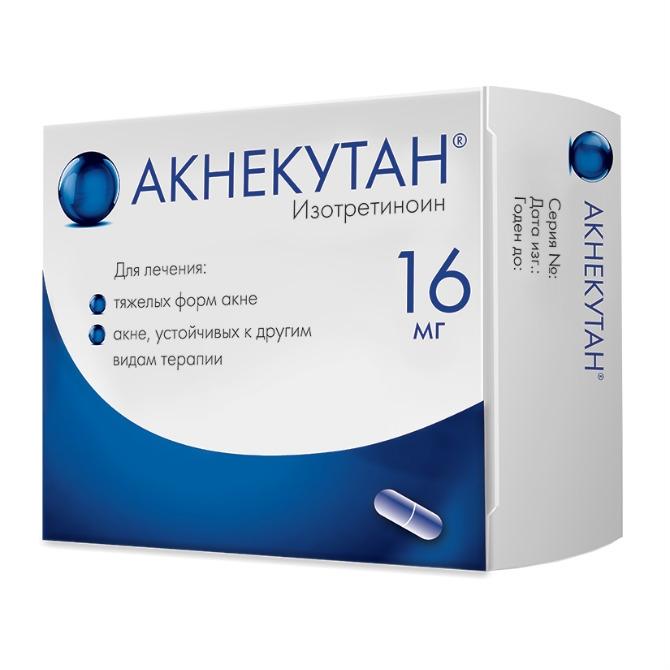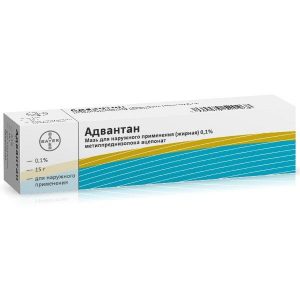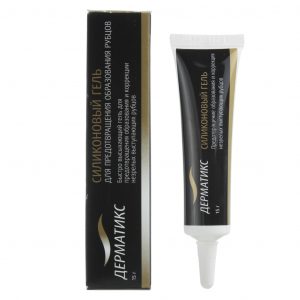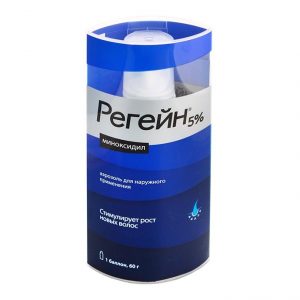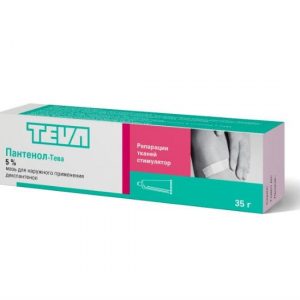Description
Release form
Capsules
Packing
30 pcs.
Pharmacological action
Isotretinoin is a stereoisomer of fully transretinoic acid (tretinoin).
The exact mechanism of action of isotretinoin has not yet been identified, but it has been established that the improvement in the clinical picture of severe forms of acne is associated with a suppression of the activity of the sebaceous glands and a histologically confirmed decrease in their size. Sebum is the main substrate for the growth of Propionibacterium acnes, therefore, a decrease in sebum formation inhibits bacterial colonization of the duct.
Aknekutan suppresses proliferation of sebocytes and acts on acne, restoring the normal process of cell differentiation, stimulates regeneration processes.
In addition, the anti-inflammatory effect of isotretinoin on the skin has been proven.
Pharmacokinetics
After oral administration, absorption is variable, Aknekutan bioavailability is low and variable – due to the proportion of dissolved isotretinoin in the drug, and may also increase when taken with food. In patients with acne, the maximum plasma concentration (Cmax) in equilibrium after taking 80 mg of isotretinoin on an empty stomach was 310 ng / ml (range 188-473 ng / ml) and was reached after 2-4 hours. The concentration of isotretinoin in plasma is 1.7 times higher than in the blood, due to poor penetration of isotretinoin into red blood cells. Communication with plasma proteins (mainly with albumin) – 99.9%.
Equilibrium concentrations of isotretinoin in the blood (Css) in patients with severe forms of acne who took 40 mg of the drug 2 times a day ranged from 120 to 200 ng / ml. The concentrations of 4-oxo-isotretinoin (the main metabolite) in these patients were 2.5 times higher than those of isotretinoin.
The concentration of isotretinoin in the epidermis is 2 times lower than in serum. It is metabolized with the formation of 3 main biologically active metabolites – 4-oxo-isotretinoin (main), tretinoin (fully transretinoic acid) and 4-oxo-retinoin, as well as less significant metabolites, which also include glucuronides. Since in vivo isotretinoin and tretinoin are reversibly converted into each other, the metabolism of tretinoin is associated with the metabolism of isotretinoin. 20-30% of the dose of isotretinoin is metabolized by isomerization. Enterohepatic circulation can play a significant role in the pharmacokinetics of isotretinoin in humans.
In vitro studies have shown that several CYP enzymes are involved in the conversion of isotretinoin to 4-oxo-isotretinoin and tretinoin. Moreover, none of the isoforms, apparently, plays a dominant role. Isotretinoin and its metabolites do not significantly affect the activity of CYP enzymes.
The half-life of the terminal phase for isotretinoin is an average of 19 hours. The half-life of the terminal phase for 4-oxo-isotretinoin is an average of 29 hours.
Isotretinoin is excreted by the kidneys and with bile in approximately equal amounts. Refers to natural (physiological) retinoids. Endogenous retinoid concentrations are restored approximately 2 weeks after the end of the drug.
Pharmacokinetics in special clinical cases
Since data on the pharmacokinetics of the drug in patients with impaired liver function are limited, isotretinoin is contraindicated in this group of patients. Renal failure of mild to moderate severity does not affect the pharmacokinetics of isotretinoin.
Indications
Severe forms of acne (nodular – cystic, conglobate, acne with a risk of scar formation).
Acne not amenable to other types of therapy.
Contraindications
Pregnancy, established and planned (possibly teratogenic and embryotoxic effects), lactation period, liver failure, hypervitaminosis A, severe hyperlipidemia, concomitant tetracycline therapy.
Hypersensitivity to the drug or its components. Aknekutan is not indicated in the treatment of puberty acne and is not recommended for use by children under 12 years of age.
Precautions
Diabetes mellitus, history of depression, obesity, impaired lipid metabolism, alcoholism.
Male Patients:
Existing evidence suggests that in women, exposure to the drug from the seed and seminal fluid of men taking Aknekutan is not sufficient for teratogenic effects of Aknekutan to occur. Men should exclude the possibility of taking the drug by others, especially women.
If, despite the precautions taken, during treatment with Aknekutan or within a month after its termination, pregnancy nevertheless has come, there is a high risk of very severe malformations of the fetus. If pregnancy occurs, therapy with Aknekutan is stopped. The advisability of preserving it should be discussed with a doctor specializing in teratology.
Since isotretinoin is highly lipophilic, it is very likely that it passes into breast milk. Due to possible side effects, Aknekutan should not be prescribed to nursing mothers.
Use during pregnancy and lactation
Pregnancy is an absolute contraindication for therapy with Aknekutan. If pregnancy occurs, despite warnings, during treatment or within a month after the end of therapy, there is a very high risk of having a baby with severe malformations.
Isotretinoin is a drug with a strong teratogenic effect. If pregnancy occurs during the period when a woman is taking isotretinoin orally (at any dose, or even for a short time), there is a very big risk of having a baby with developmental defects.
Aknekutan is contraindicated in women of childbearing age, if only the woman s condition does not meet all of the following criteria: she must suffer from severe acne, resistant to conventional
treatment methods, she must surely understand and follow the doctor s instructions
she must be informed by the doctor about the danger of pregnancy during treatment with Aknekutan, within one month after it and urgent consultation in case of suspected pregnancy
she should be warned about the possible ineffectiveness of contraception
she must confirm that understands the essence of
precautions, she must understand the need and continuously use effective methods of contraception for one month before treatment with Aknekutan, during treatment and within a month after its completion (see section Interaction with other medicines ) it is desirable to use simultaneously 2 different methods of contraception, including barrier
, she should have a negative result of a reliable pregnancy test within 11 days before starting the drug, a pregnancy test is strongly recommended monthly during treatment and 5 weeks after the end of
therapy, she should start treatment with Aknekutan only on the 2-3rd day of the next normal
menstrual cycle, she should understand To make it necessary to visit a doctor every month
for treatment for relapse, she must constantly use the same effective methods of contraception for one month before starting treatment with Aknekutan, during treatment and for a month after its completion, as well as undergoing the same reliable pregnancy test
, she must fully understand the need for precautionary measures and confirm her understanding and desire to use reliable contraception methods, which the doctor explained to her.
The use of contraceptives according to the above instructions during treatment with isotretinoin should be recommended even to those women who usually do not use contraceptive methods because of infertility (with the exception of patients who underwent a hysterectomy), or who report that they do not have sex.
The doctor must be sure that: the patient suffers from severe acne (nodular-cystic, conglobate acne or acne with a risk of scar formation) acne, not resistant to other types of
therapy, a negative result of a reliable pregnancy test was obtained before taking the drug, during therapy and 5 weeks after the end of therapy, the dates and results of the pregnancy test must be documented
the patient uses at least 1, preferably 2 effective methods of contraception, including the barrier method, within one month before the start of treatment with Aknekutan, during treatment and within a month after its completion, the patient is able to understand and perform everything in sheperechislennye requirements on protection from pregnancy
patient meets all the above conditions.
Pregnancy Test
In accordance with current practice, A pregnancy test with a minimum sensitivity of 25 mME / ml should be performed on the first 3 days of the menstrual cycle:
Before treatment: To exclude a possible pregnancy, the result and date of the initial pregnancy test should be registered by a doctor before starting contraception. In patients with irregular menstruation, the time for a pregnancy test depends on sexual activity, it should be done 3 weeks after unprotected intercourse. The doctor should inform the patient about contraception methods.
A pregnancy test is performed on the day of Aknekutan’s appointment or 3 days before the patient s visit to the doctor. The specialist should record the test results. The drug can only be prescribed to patients receiving effective contraception for at least 1 month before starting Aknekutan therapy.
During therapy: The patient should see a doctor every 28 days. The need for monthly pregnancy testing is determined in accordance with local practice and taking into account sexual activity, previous menstrual irregularities. If there is evidence, a pregnancy test is performed on the day of the visit or three days before the visit to the doctor, the test results must be recorded.
End of therapy: 5 weeks after the end of therapy, a test is done to rule out pregnancy.
A prescription for Aknekutan to a woman capable of childbearing can be prescribed only for 30 days of treatment, continued therapy requires a new prescription of the drug by a doctor. It is recommended that a pregnancy test, prescription and receipt of the drug be carried out in one day.
Aknekutan should only be given at a pharmacy within 7 days of issuing a prescription.
Special instructions
It is recommended to monitor liver function and liver enzymes before treatment, 1 month after it is started, and then every 3 months or as indicated. A transient and reversible increase in hepatic transaminases was noted, in most cases within normal values. If the level of hepatic transaminases exceeds the norm, it is necessary to reduce the dose of the drug or cancel it. You should also determine the level of lipids in fasting serum before treatment, 1 month after the start, and then every 3 months or as indicated. Typically, lipid concentrations are normalized after a dose reduction or drug withdrawal, as well as dieting. It is necessary to control a clinically significant increase in the level of triglycerides, since their rise above 800 mg / dl or 9 mmol / l may be accompanied by the development of acute pancreatitis, possibly with a fatal outcome.
With persistent hypertriglyceridemia or symptoms of pancreatitis, Acnecutan should be discontinued. In rare cases, patients receiving Aknekutan described depression, psychotic symptoms, and very rarely suicidal attempts. Although their causal relationship with the use of the drug has not been established, special care must be taken in patients with a history of depression and all patients should be monitored for depression during treatment with the drug, if necessary referring them to the appropriate specialist. However, the withdrawal of Aknekutan may not lead to the disappearance of symptoms and further monitoring and treatment by a specialist may be required.
In rare cases, at the beginning of therapy, exacerbation of acne is noted, which disappears within 7-10 days without dose adjustment.
When prescribing the drug to any patient, the ratio of the possible benefit and risk should be carefully evaluated first.
Patients receiving Aknekutan are advised to use moisturizing ointment or body cream, lip balm to reduce dry skin and mucous membranes at the beginning of therapy.
Against the background of taking Aknekutan, pain in muscles and joints, an increase in serum creatinine phosphokinase, which may be accompanied by a decrease in tolerance to intense physical activity, are possible.
Avoid deep chemical dermabrasion and laser treatment in patients receiving Aknekutan, as well as within 5-6 months after treatment due to the possibility of increased scarring in atypical places and the occurrence of hyper- and hypopigmentation. During treatment with Aknekutan and for 6 months after it, it is impossible to carry out hair removal using wax applications because of the risk of epidermal detachment, the development of scars and dermatitis. Since some patients may experience a decrease in visual acuity, which sometimes persists even after the end of therapy, patients should be informed about the possibility of this condition, recommending that they be careful when driving at night. The state of visual acuity must be carefully monitored. Dry conjunctiva, clouding of the cornea, impaired night vision and keratitis usually disappear after discontinuation of the drug. When the mucous membrane of the eyes is dry, applications of a moisturizing eye ointment or an artificial tear preparation can be used. It is necessary to observe patients with dry conjunctiva for possible development of keratitis. Patients complaining of vision should be referred to an ophthalmologist and consider the advisability of canceling Aknekutan. In case of intolerance to contact lenses, glasses should be used during therapy. The effects of solar insolation and UV therapy should be limited. If necessary, use a sunscreen with a high protective factor of at least 15 SPF.
Rare cases of the development of benign intracranial hypertension ( ² Ñpseudotumor of the brain ² Ñ), including with combined use with tetracyclines. In such patients, Aknekutan should be withdrawn immediately. With Aknekutan therapy, an inflammatory bowel disease may occur. In patients with severe hemorrhagic diarrhea, Aknekutan should be withdrawn immediately.
Rare cases of anaphylactic reactions that occurred only after previous external use of retinoids are described. Severe allergic reactions dictate the need for drug withdrawal and close monitoring of the patient.
High-risk patients (with diabetes, obesity, chronic alcoholism, or impaired fat metabolism) may need more frequent laboratory monitoring of glucose and lipids during treatment with Aknekutan. If you have or suspect diabetes, a more frequent definition of glycemia is recommended.
Patients with diabetes mellitus are advised to monitor their blood glucose more frequently.
During the treatment period, care must be taken when driving vehicles and engaging in other potentially dangerous activities that require an increased concentration of attention and speed of psychomotor reactions (when taking the first dose).
During the treatment period and within 30 days after its completion, it is necessary to completely exclude blood sampling from potential donors in order to completely exclude the possibility of getting this blood to pregnant patients (high risk of developing teratogenic and embryotoxic effects). Release form Capsules 8 mg and 16 mg. 10 or 14 capsules in a PVC blister coated with aluminum foil.
Blisters-10-N2, N3, N5, N6, N9, N10 blisters-14-N1, N2, N4, N7 in a cardboard box along with instructions for use.
Composition
Composition per 1 capsule
Active ingredients: Isotretinoin 16.0 mg
Excipients: Gelucir® 50/13 (a mixture of stearic acid esters of polyethylene oxide and glycerol), purified soybean oil, Span 80® (sorbitan oleate oleate – and sorbitol).
Capsule composition: body: gelatin, titanium dioxide (E171),
cap: gelatin, titanium dioxide (E171), dye iron oxide yellow (E172), indigo carmine (E132).
Dosage and administration
Inside, preferably with meals, 1-2 times a day.
The therapeutic efficacy of Aknekutan and its side effects are dose dependent and vary in different patients. This makes it necessary to individually select the dose during treatment.
The initial dose of Aknekutan is 0.4 mg / kg per day, in some cases up to 0.8 mg / kg per day. In severe forms of the disease or with acne of the body, a dose of up to 2 mg / kg per day may be required.
The optimal course cumulative dose is 100-120 mg / kg. Complete remission is usually achieved in 16-24 weeks. With poor tolerance of the recommended dose, treatment can be continued at a lower dose, but longer. In most patients, acne completely disappears after a single course of treatment.
In relapse, a second course of treatment is possible in the same daily and cumulative dose. A second course is prescribed no earlier than 8 weeks after the first, since the improvement may be delayed.
In severe chronic renal failure, the initial dose should be reduced to 8 mg / day.
Side effects of
Most side effects are dose-related. Usually, side effects are reversible after dose adjustment or drug withdrawal, but some may persist after treatment is discontinued. Symptoms associated with hypervitampnosis A: dry skin, mucous membranes, including lips (cheilitis), nasal cavity (bleeding), larynx and pharynx (hoarseness of the voice), eyes (conjunctivitis, reversible clouding of the cornea and intolerance to contact lenses).
Skin and its appendages: peeling of the skin of the palms and soles, rash, itching, erythema of the face / dermatitis, sweating, pyogenic granuloma, paronychia, onychodystrophy, increased growth of granulation tissue, persistent thinning of the hair, reversible hair loss, fulminant forms of acne, hyperi , photosensitivity, mild skin trauma. At the beginning of treatment, exacerbation of acne may occur, lasting several weeks.
Musculoskeletal system: muscle pain with increased levels of CPK in the serum or without it, joint pain, hyperostosis, arthritis, calcification of ligaments and tendons, tendonitis.
Central nervous system and mental sphere: excessive fatigue, headache, increased intracranial pressure ( pseudotumor of the brain : headache, nausea, vomiting, visual impairment, swelling of the optic nerve), convulsive seizures, rarely depression, psychosis, suicidal thoughts. Sensory organs: xerophthalmia, individual cases of visual acuity disturbance, photophobia, impaired dark adaptation (diminished twilight visual acuity), rarely – color perception disorder (after drug withdrawal), lenticular cataract, keratitis, blepharitis, conjunctivitis, eye irritation, optic neuritis, swelling of the optic nerve (as a manifestation of intracranial hypertension) hearing impairment at certain sound frequencies, difficulty wearing contact lenses.
Gastrointestinal tract: dry oral mucosa, gum bleeding, gum disease, nausea, diarrhea, inflammatory bowel disease (colitis, ileitis), bleeding pancreatitis (especially with concomitant hypertriglyceridemia above 800 mg / dl). Rare cases of pancreatitis with a fatal outcome are described. Transient and reversible increase in hepatic transaminase activity, individual cases of hepatitis. In many of these cases, the changes did not go beyond the normal range and returned to the initial indicators during the treatment process, however, in some situations it was necessary to reduce the dose or cancel Aknekutan.
Respiratory organs: rarely – bronchospasm (more often in patients with a history of bronchial asthma).
Blood system: anemia, decreased hematocrit, leukopenia, neutropenia, increased or decreased platelet count, accelerated ESR.
Laboratory indicators: hypertriglyceridemia, hypercholesterolemia, hyperuricemia, a decrease in the level of high density lipoproteins, rarely hyperglycemia. During the administration of Aknekutan, cases of newly diagnosed diabetes were recorded. In some patients, especially those involved in intense physical activity, individual cases of increased activity of CPK in serum are described.
Immune system: local or systemic infections caused by gram-positive pathogens (Staphylococcus aureus).
Other: lymphadenopathy, hematuria, proteinuria, vasculitis (Wegener’s granulomatosis, allergic vasculitis), systemic hypersensitivity reactions, glomerulonephritis.
Teratogenic and embryotoxic effects: congenital malformations – hydro- and microcephaly, underdevelopment of the cranial nerves, microphthalmia, malformations of the CVS, parathyroid glands, skeletal malformations – underdevelopment of the finger phalanges, skull, cervical vertebrae, femur, forefoot, facial skull, cleft palate, low location of the auricles, underdevelopment of the auricles, underdevelopment or complete absence of an external auditory meatus, hernia of the brain and spinal cord, bone fusion, joint of fingers and toes, impaired development of the thymus, death of the fetus during the perinatal period, premature birth , miscarriages), premature closure of epiphyseal growth zones in an animal experiment – pheochromocytoma.
Drug interaction
Tetracycline antibiotics, corticosteroids reduce effectiveness. The simultaneous use with drugs that increase photosensitivity (including sulfonamides, tetracyclines, thiazide diuretics) increases the risk of sunburn.
Concomitant use with other retinoids (including acitretin, tretinoin, retinol, tazarotene, adapalene) increases the risk of hypervitaminosis A.
Isotretinoin can weaken the effectiveness of progesterone preparations, therefore, contraceptives containing small doses of progesterone should not be used.
Concomitant use with topical keratolytic drugs for the treatment of acne is not recommended because of the possible increase in local irritation. Since tetracyclines increase the risk of increased intracranial pressure, simultaneous use with isotretinoin is contraindicated.
Overdose
In the event of an overdose, signs of hypervitaminosis A. may occur in the first few hours after overdose.
Storage Conditions
Store in a dry, dark place out of the reach of children at a temperature not exceeding 25 ° C.
Shelf life
2 years. Do not use after expiration date.
Deystvuyushtee substance
Isotretinoin
Pharmacy terms
Prescription
dosage form
capsules
For
For prescription
For children For a doctor as prescribed by a doctor, For children over 12 years old
o Yadran ., Croatia
